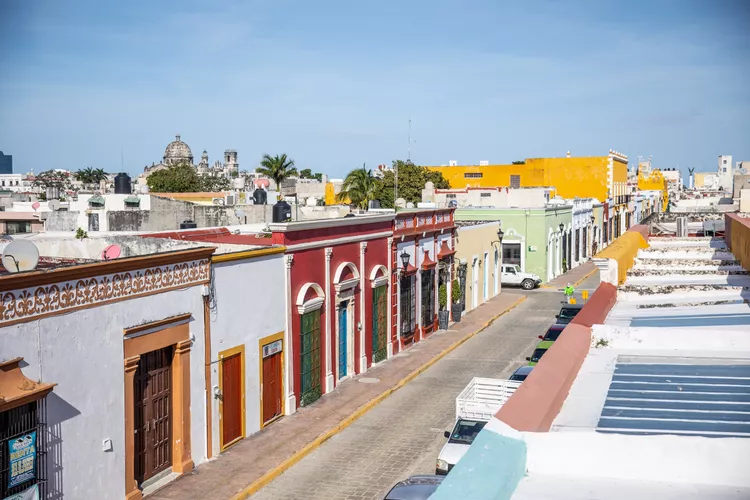1. Introduction
Mexico offers much more than just its stunning beaches. Several Mexican cities have earned recognition from UNESCO for their outstanding universal value and are celebrated for their remarkable portfolio of cultural heritage. These cities feature beautiful colonial architecture, lively marketplaces, and a variety of cultural experiences throughout the year. Dive into the rich offerings of Mexico by exploring these distinguished cities.
2. Campeche

Founded in 1540, the port city of Campeche was often threatened by pirate attacks, leading to the construction of a defensive wall in the 17th century. The colonial buildings within this fortified city are painted in a variety of pastel colors, contrasted against the grey stone walls and bastions. Explore more about Campeche or visit the nearby archaeological site of Edzna for a glimpse into its historical significance.
3. Guanajuato

Once a bustling silver mining town, Guanajuato boasts winding streets, some of which are underground, lending it an intimate ambiance. Known for its vibrant culture and hosting the important cultural event, the Festival Cervantino, held every October, this town is the birthplace of renowned Mexican artist Diego Rivera. Must-see attractions include the Mummy Museum and the panoramic view from the El Pipila monument.
4. Mexico City

As one of the largest and oldest continuously-occupied cities in the Americas, Mexico City has a rich history dating back to 1300s when the Aztecs established it. After the Spanish conquest in the 1500s, they built on the ruins of Tenochtitlan. Mexico City offers a vast array of sightseeing, shopping, accommodations, and entertainment options. Visitors can enjoy rich cultural experiences and explore its diverse culinary scene.
5. Morelia

Morelia is renowned for its elegance, with many colonial structures built from pink quarry stone. Originally called Valladolid, it was renamed in honor of independence hero Jose Maria Morelos de Pavon. Often referred to as the candy capital of Mexico, visitors should definitely explore the Museo del Dulce. Additionally, excursions to nearby Patzcuaro or the monarch butterfly reserves are highly recommended.
6. Oaxaca

Recognized by UNESCO, Oaxaca city, along with the nearby archaeological site of Monte Alban, showcases the beauty of Spanish colonial town planning established in 1642. Its buildings stand as solid constructions adapted to the earthquake-prone region. Monte Alban, once the capital of the Zapotecs, provides deep historical insights. Additionally, Oaxaca is famed for its exceptional culinary offerings, making it a top foodie destination.
7. Puebla

Puebla, one of Mexico’s largest cities, retains a charming historical center ideal for exploration on foot. Located a couple of hours from Mexico City near the volcanoes Popocatépetl and Iztaccíhuatl, Puebla showcases many remarkable colonial-era religious structures, such as the 16th-century cathedral, and its gorgeous buildings adorned with azulejos (decorative tiles). The unique fusion of European and American styles evident in Puebla’s architecture is particularly striking.
8. Querétaro

Situated about two hours north of Mexico City, Querétaro is a tranquil colonial city founded in 1531. Its charming architecture and original street layouts—combining a grid system introduced by the Spaniards with winding alleys typical of indigenous towns—create a unique urban landscape. Visitors can admire numerous Baroque monuments from the 17th and 18th centuries. Nearby attractions include the Magical Town of Bernal with its stunning monolith, and vineyards of picturesque Tequisquiapan.
9. San Miguel de Allende

Once a mining hub along the Camino Real, San Miguel de Allende is now a picturesque artistic town attracting numerous expatriates. Its striking architecture reflects the rich cultural interchange among Spaniards, Creoles, and indigenous peoples. Notable sites include the Sanctuary of Jesús Nazareno de Atotonilco, representing the fusion of European and Latin American cultures.
10. Tlacotalpan

This port town, positioned along the Papaloapan river in Veracruz, was founded in the mid-16th century. Due to the frequent fires in the 18th century, town authorities mandated that homes use tile roofs and have large patios to prevent fire spread, conferring a unique aesthetic to the town. The architecture in Tlacotalpan distinctly follows Caribbean traditions rather than typical Spanish colonial styles, with lush greenery enhancing its charm. The Dia de la Candelaria (Candlemas) is celebrated here with vibrant festivities.
11. Zacatecas

Founded in 1546 after discovering mineral deposits, Zacatecas emerged as one of the most prominent mining towns in New Spain. Its historic center is adorned with magnificent churches and breathtaking Baroque architecture, with the cathedral standing out as an exceptional example of churrigueresque design.





